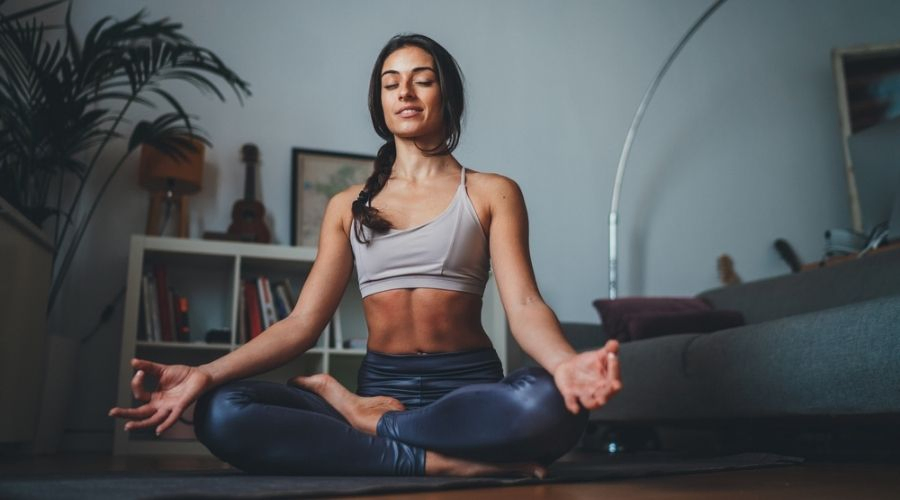I. Introduction

The benefits of regular yoga practice
Yoga is a holistic practice that encompasses physical, mental, and spiritual well-being. Regular engagement in yoga offers numerous benefits, including improved flexibility, strength, balance, and posture. It also promotes stress reduction, relaxation, mental clarity, and emotional well-being. Additionally, yoga offers a space for self-reflection, mindfulness, and personal growth.
Understanding the importance of finding the right frequency
While committing to regular yoga practice is essential, finding the right frequency that suits your individual needs is equally important. Practicing yoga too frequently can lead to burnout, exhaustion, or even injury, while practicing too infrequently may not yield the desired benefits. Therefore, it is crucial to consider various factors that influence the appropriate frequency of your yoga practice.
II. Determining Factors for Yoga Frequency
A. Personal Goals and Objectives
- Identifying individual needs and aspirations
Before establishing the frequency of your yoga practice, it is essential to identify your personal goals and objectives. These may include physical fitness, stress reduction, mental clarity, spiritual growth, or a combination of these. Understanding your intentions will help guide you in determining the frequency that best aligns with your aspirations.
- Aligning practice frequency with desired outcomes
Once you have identified your goals, it is important to align the frequency of your yoga practice with the desired outcomes. For example, if you aim to enhance your physical fitness, such as improving flexibility or building strength, a more frequent practice may be beneficial. On the other hand, if your main objective is stress reduction or mindfulness, a moderate and balanced frequency may be more appropriate.
B. Physical Condition and Fitness Level
- Assessing personal limitations and abilities
Consider your current physical condition and fitness level when determining the frequency of your yoga practice. If you are a beginner or recovering from an injury, it may be wise to start with a lower frequency and gradually increase as your body becomes accustomed to the practice. Assessing your physical limitations and abilities will help prevent overexertion and reduce the risk of injury.
- Adjusting practice frequency to safeguard against injury
Maintaining a balanced and sustainable yoga practice requires listening to your body and adjusting the frequency accordingly. If you feel soreness, fatigue, or pain after practicing, it may be a sign that you need to reduce the frequency or modify your practice. Prioritizing rest and recovery is crucial to prevent overuse injuries and support the longevity of your yoga journey.
C. Time Constraints and Availability
- Considering daily schedule and commitments
Evaluate your daily schedule and commitments to determine how much time you can dedicate to your yoga practice. Depending on your availability, you may choose to incorporate shorter and more frequent sessions or longer sessions a few times per week. Find a schedule that works best for you and can be consistently maintained.
- Exploring different options for accommodating practice time
If time constraints limit your practice, explore alternative options for accommodating your yoga sessions. Consider waking up earlier, utilizing breaks during the day, or incorporating yoga into your evening routine. Additionally, exploring online yoga platforms or pre-recorded classes can provide flexibility in practicing at your convenience.
III. Recommended Frequencies for Different Situations
A. Beginners

- Guided classes or online lessons for foundational learning
For beginners, it is recommended to start with guided classes or online lessons to learn the foundational principles and postures of yoga. These classes provide proper guidance and ensure that beginners practice in a safe and effective manner.
- Starting with 2-3 sessions per week to build strength and flexibility
As beginners, it is important not to overwhelm the body with too much physical strain. Starting with 2-3 yoga sessions per week allows the body to adapt gradually and build strength and flexibility over time.
B. Fitness Maintenance and Stress Management
- Sustaining overall well-being with 2-3 weekly sessions
For individuals looking to maintain overall physical and mental well-being, a frequency of 2-3 yoga sessions per week is recommended. This regularity helps to sustain the positive effects of yoga on fitness, stress reduction, and overall health.
- Mixing yoga with other physical activities
To diversify your fitness routine and enhance overall physical fitness, consider mixing yoga with other physical activities such as cardio exercises, strength training, or sports. Incorporating yoga 2-3 times a week, along with other activities, provides a well-rounded approach to physical fitness.
C. Intensive Progress and Advancement

- Seeking accelerated growth with 4-5 sessions per week
For those seeking accelerated progress in their yoga practice, an increased frequency of 4-5 sessions per week can be beneficial. This higher frequency allows for deeper exploration of various poses, greater focus on alignment and technique, and a faster advancement in strength, flexibility, and overall proficiency.
- Combining different yoga styles for well-rounded development
To ensure a well-rounded development and to challenge the body and mind, consider combining different yoga styles within the 4-5 weekly sessions. This combination enables practitioners to explore various principles, techniques, and philosophies of yoga, leading to a more comprehensive practice.
IV. Listening to Your Body
A. Identifying signs of overtraining or burnout
It is crucial to listen to your body and be aware of any signs of overtraining or burnout. Common signs may include persistent muscle soreness, decreased performance, chronic fatigue, mood swings, or increased susceptibility to injuries. If these signs arise, it’s important to dial back the frequency or intensity of practice to allow for adequate rest and recovery.
B. Adjusting frequency based on individual energy levels and recovery time

Every person’s body is unique, and energy levels may vary from day to day. It’s essential to be mindful of your energy levels and adjust the frequency of your yoga practice accordingly. If you feel physically or mentally fatigued, taking a day or two off or practicing gentle, restorative yoga can aid in recovery.
V. Flexibility in Frequency
A. Adapting practice to life circumstances and changes
Life circumstances and commitments may shift over time, impacting the availability for yoga practice. It’s important to adapt and be flexible with your practice as per your changing schedule. If you find it challenging to maintain the recommended frequency, even reducing the number of sessions while keeping a consistent practice can be beneficial.
B. Embracing variations and modifications when necessary
When faced with time constraints or physical limitations, it is important to embrace variations and modifications in your practice. This allows you to accommodate your situation while still reaping the benefits of yoga. Utilize shorter sessions, targeted practices, or modify poses as needed to continue your practice.
Overall, the recommended frequencies provide a guideline to help individuals identify an appropriate frequency for their yoga practice. However, it is important to remember that these recommendations are not fixed rules but should be viewed as a starting point. Ultimately, it’s crucial to listen to your body, personalize your practice, and find the frequency that supports your overall well-being and goals.



